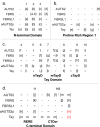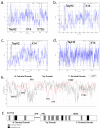Ancestry of the AUTS2 family-A novel group of polycomb-complex proteins involved in human neurological disease
- PMID: 33306672
- PMCID: PMC7732068
- DOI: 10.1371/journal.pone.0232101
Ancestry of the AUTS2 family-A novel group of polycomb-complex proteins involved in human neurological disease
Abstract
Autism susceptibility candidate 2 (AUTS2) is a neurodevelopmental regulator associated with an autosomal dominant intellectual disability syndrome, AUTS2 syndrome, and is implicated as an important gene in human-specific evolution. AUTS2 exists as part of a tripartite gene family, the AUTS2 family, which includes two relatively undefined proteins, Fibrosin (FBRS) and Fibrosin-like protein 1 (FBRSL1). Evolutionary ancestors of AUTS2 have not been formally identified outside of the Animalia clade. A Drosophila melanogaster protein, Tay bridge, with a role in neurodevelopment, has been shown to display limited similarity to the C-terminal of AUTS2, suggesting that evolutionary ancestors of the AUTS2 family may exist within other Protostome lineages. Here we present an evolutionary analysis of the AUTS2 family, which highlights ancestral homologs of AUTS2 in multiple Protostome species, implicates AUTS2 as the closest human relative to the progenitor of the AUTS2 family, and demonstrates that Tay bridge is a divergent ortholog of the ancestral AUTS2 progenitor gene. We also define regions of high relative sequence identity, with potential functional significance, shared by the extended AUTS2 protein family. Using structural predictions coupled with sequence conservation and human variant data from 15,708 individuals, a putative domain structure for AUTS2 was produced that can be used to aid interpretation of the consequences of nucleotide variation on protein structure and function in human disease. To assess the role of AUTS2 in human-specific evolution, we recalculated allele frequencies at previously identified human derived sites using large population genome data, and show a high prevalence of ancestral alleles, suggesting that AUTS2 may not be a rapidly evolving gene, as previously thought.
Conflict of interest statement
The authors have declared that no competing interests exist.
Figures






References
-
- Beunders G, van de Kamp J, Vasudevan P, Morton J, Smets K, Kleefstra T, et al. A detailed clinical analysis of 13 patients with AUTS2 syndrome further delineates the phenotypic spectrum and underscores the behavioural phenotype. Journal of Medical Genetics. 2016;53(8):523 10.1136/jmedgenet-2015-103601 - DOI - PubMed
-
- Beunders G, Voorhoeve E, Golzio C, Pardo Luba M, Rosenfeld Jill A, Talkowski Michael E, et al. Exonic Deletions in AUTS2 Cause a Syndromic Form of Intellectual Disability and Suggest a Critical Role for the C Terminus. American Journal of Human Genetics. 2013;92(2):210–20. 10.1016/j.ajhg.2012.12.011 - DOI - PMC - PubMed
MeSH terms
Substances
LinkOut - more resources
Full Text Sources
Molecular Biology Databases
Research Materials

